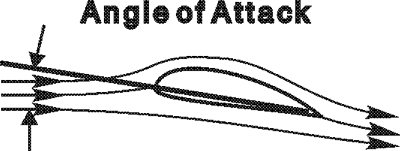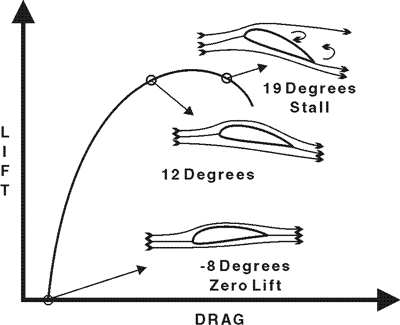INSIDE
RACING
T E C H N O L O G Y
IRT Home
IRT Home
News Page
Contents Page
Newsletter &
Books
email Paul
Angle of Attack
Angle of Attack
The difference between where the wing is pointed and the direction of the air flowing over the wing is the angle of attack as shown in this schematic.

The graph below shows how lift and drag changes with the angle of attack for a typical wing design.

Where the curve crosses the Drag axis is where the wing is generating zero lift. Notice the angle of attack at that point is a negative value. That means a typical wing has to point down to get to zero lift. Notice, also, there is some drag at zero lift. There is, truly, no free lunch.
As the nose of the wing turns up, angle of attack increases, and lift increases. Drag goes up also, but not as quickly as lift. Think about the last time you took a trip on an airplane. During take-off an airplane builds up to a certain speed and then the pilot “rotates” the plane; that is, the pilot manipulates the controls so that the nose of the plane comes up and, at some angle of attack, the wings generate enough lift to take the plane into the air. Since an airplane wing is fixed to the fuselage, the whole plane has to rotate to increase the wing's angle of attack.
A wing is fairly efficient. You get a lot of lift without much drag—until you get to about 12 degrees angle of attack on this curve. Then drag goes way up, without creating much more lift. As the angle of attack increases from 12 to 19 degrees for this particular design, there isn’t much increase in lift but you have a lot more drag. We say the wing is “stalled” when lift decreases at increasingly higher angles of attack.
The shape of this curve is why you read about airplane crashes during stormy takeoffs and landings. Under conditions of low speed and high lift, the plane is rotated up there near the top of the curve. If the plane has to climb and the pilot tries to bring the nose up, he gets more drag and not much more lift. What he really needs is more airspeed. A few years ago most airlines changed their procedures and you don't see planes landing at high angles of attack any more.
Front wings on racecars are fabricated so the angle of attack is easily adjustable to vary the amount of downforce needed to balance the car for the driver. You see that happening at pit stops during a race. Rear wings are also adjusted by changing the angle of attack but that takes too much time for a pit stop. Sometimes you'll see a team change a Gurney flap during a pit stop and that's the next Race Tech story coming soon.